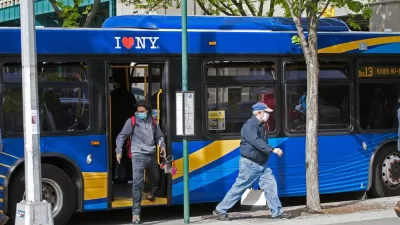Even as gas prices rise, ridership on many public transit systems continues to remain well below pre-pandemic levels.

In a piece for Marketplace, Savannah Maher describes the slow return of public transit ridership, which remains sluggish despite high gas prices, which some agencies hoped “would nudge some of us onto city buses and trains and help transit ridership recover from the nosedive it took during the pandemic.”
With remote work still hugely popular, transit systems in tech hubs like San Francisco are still seeing low ridership numbers. In the case of Bay Area Rapid Transit (BART), ridership sits at 30 to 35 percent of pre-pandemic levels, when the system carried roughly 400,000 people across the Bay Area every weekday.
Some agencies have reduced or eliminated fares to lure riders back, but the future of fare-free transit programs hinges on uncertain funding sources. But while free fares or service changes may help bring riders back, the prevalence of remote work means that some changes in commuting patterns are likely here to stay, upending long-established models of service geared towards 9-to-5 commutes. Systems in cities with high numbers of remote workers will likely have to make some transformative changes to serve the needs of remaining riders and establish new funding models that rely less heavily on farebox revenue to fund operations.
FULL STORY: Public transit ridership is slow to return, despite high gas prices

Alabama: Trump Terminates Settlements for Black Communities Harmed By Raw Sewage
Trump deemed the landmark civil rights agreement “illegal DEI and environmental justice policy.”

Planetizen Federal Action Tracker
A weekly monitor of how Trump’s orders and actions are impacting planners and planning in America.

The 120 Year Old Tiny Home Villages That Sheltered San Francisco’s Earthquake Refugees
More than a century ago, San Francisco mobilized to house thousands of residents displaced by the 1906 earthquake. Could their strategy offer a model for the present?

In Both Crashes and Crime, Public Transportation is Far Safer than Driving
Contrary to popular assumptions, public transportation has far lower crash and crime rates than automobile travel. For safer communities, improve and encourage transit travel.

Report: Zoning Reforms Should Complement Nashville’s Ambitious Transit Plan
Without reform, restrictive zoning codes will limit the impact of the city’s planned transit expansion and could exclude some of the residents who depend on transit the most.

Judge Orders Release of Frozen IRA, IIJA Funding
The decision is a victory for environmental groups who charged that freezing funds for critical infrastructure and disaster response programs caused “real and irreparable harm” to communities.
Urban Design for Planners 1: Software Tools
This six-course series explores essential urban design concepts using open source software and equips planners with the tools they need to participate fully in the urban design process.
Planning for Universal Design
Learn the tools for implementing Universal Design in planning regulations.
Clanton & Associates, Inc.
Jessamine County Fiscal Court
Institute for Housing and Urban Development Studies (IHS)
City of Grandview
Harvard GSD Executive Education
Toledo-Lucas County Plan Commissions
Salt Lake City
NYU Wagner Graduate School of Public Service





























